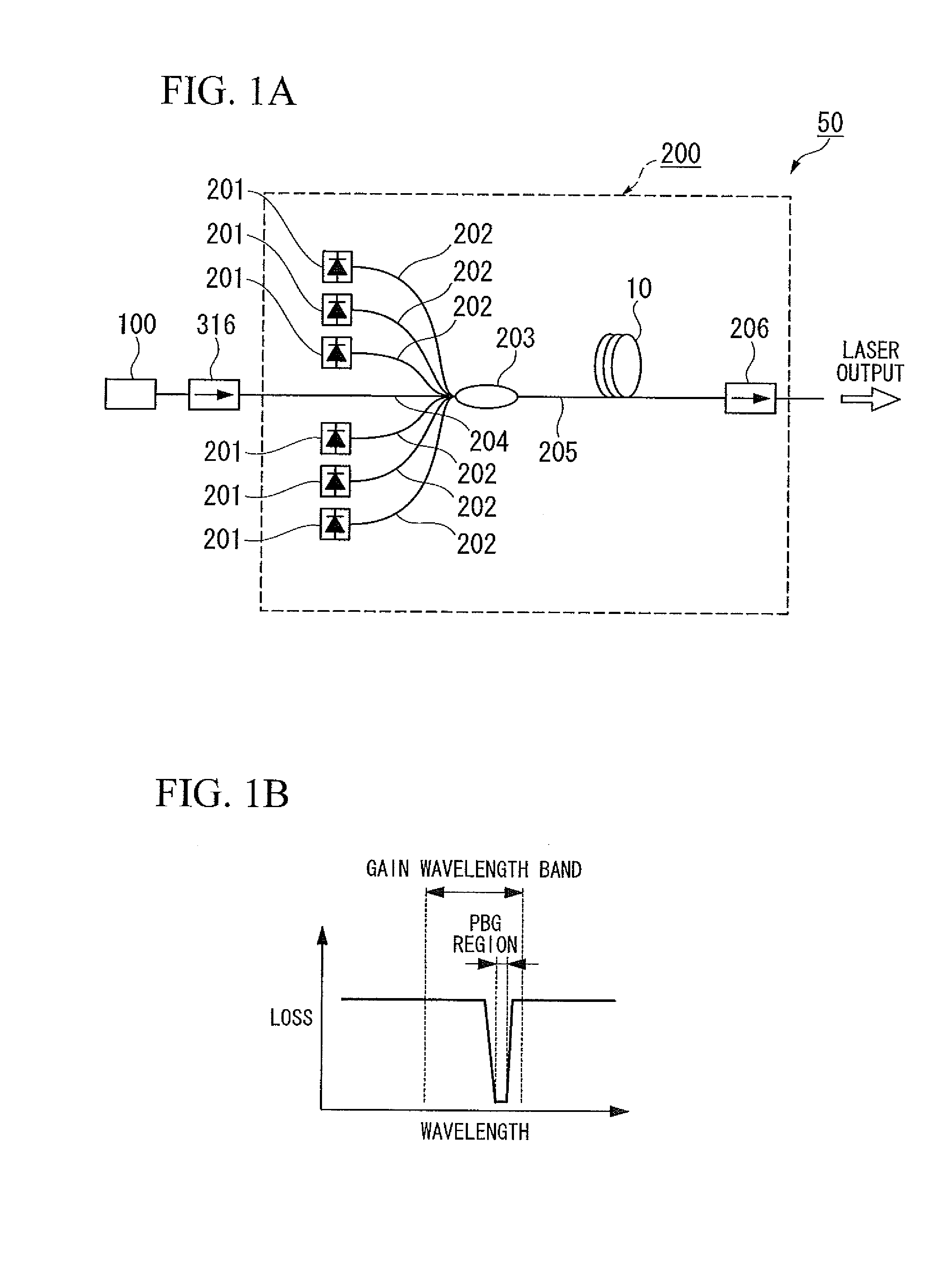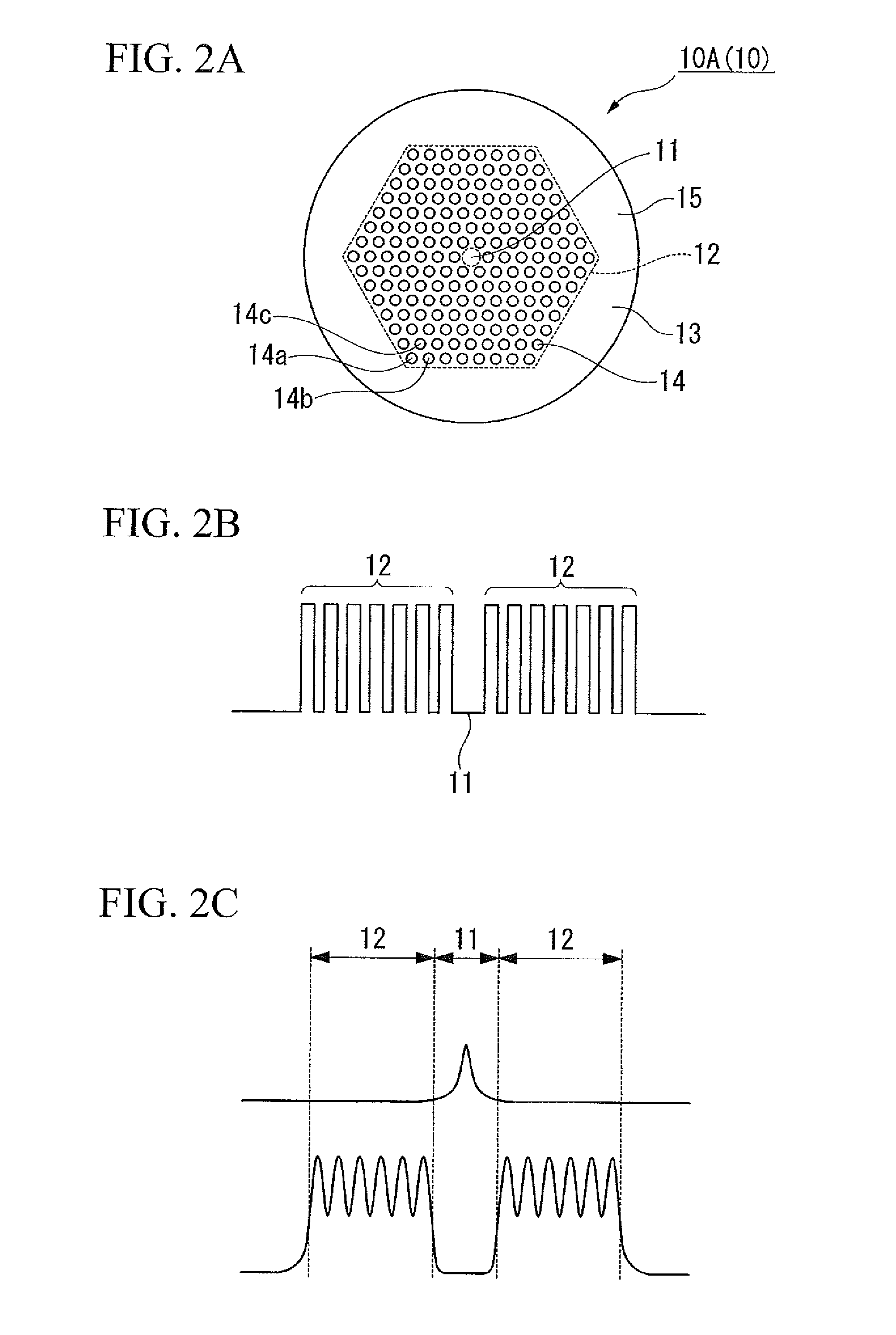Optical fiber laser
a fiber laser and optical fiber technology, applied in the field can solve the problems of affecting the excitation light source, affecting the output energy of the pulse capable of being produced from the pa b>200/b>, and reducing so as to reduce the number of optical fiber lasers, and save energy
- Summary
- Abstract
- Description
- Claims
- Application Information
AI Technical Summary
Benefits of technology
Problems solved by technology
Method used
Image
Examples
example 1
[0146]An optical fiber laser was constructed as shown in FIG. 1A.
[0147]First, as a photonic bandgap fiber, an optical fiber was fabricated that had the cross-sectional configuration as shown in FIG. 2A and the characteristics shown in FIGS. 2B, 2C. The core portion was doped with Yb ions. The core portion was fabricated so that the wavelength region in which a parasitic oscillation is most likely to occur, that is, the vicinity of 1030 nm to 1050 nm, which is a maximum gain wavelength region of the optical fiber doped with Yb ions, was excluded from the bandgap region, and that 1064 nm, which is a signal wavelength, was in the bandgap region. To be more specific, pure silica glass, which was fabricated into a core portion with a relative index difference Δc of 0% from pure silica glass and with a diameter d of 7.0 μm, was doped with Yb ions. The core portion was coated with a first cladding made of pure silica glass with a diameter of 125 μm. Around a core portion of the first cladd...
example 2
[0151]An optical fiber laser was fabricated similarly to Example 1, the exception being that the photonic bandgap fiber (hereinafter, sometimes referred to as PBGF) shown in FIGS. 3A to 3C was used instead of the PBGF used in Example 1. In the PBGF of the present example, the first layer (the innermost first layer) of the periodic structure of the PBGF of Example 1 was removed, and pure silica was used instead. At the center, pure silica glass was doped with ytterbium oxide to be functioned as an amplifying medium. Furthermore, the center was doped with aluminum oxide to form a core portion with a relative index difference of 0.3% from pure silica and with a diameter of 6 μm. The high refractive index portions had a relative index difference of 2.6% from pure silica glass. Each of the high refractive index portions had a diameter of 4.8 μm, and the distance therebetween was 6 μm. The first cladding was configured to have a diameter of 125 μm. A layer of fluorine-based ultraviolet-cu...
example 3
[0165]The PBGF of Comparative Example 2 was modified to have an increased number only of layers of the periodic structure so as to allow more components to be guided through the periodic structure, to thereby fabricate a PBGF capable of securing a connection loss of approximately 25 dB on the entrance side and the exit side. The PBGF had a core portion with a diameter of 6 μm, a first cladding with a diameter of 125 μm, and a core absorption amount of 1200 dB / m at a wavelength of 976 nm. The PBGF was used to construct an optical fiber laser similarly to in Example 1. This was used as the optical fiber laser of Example 3. In the optical fiber laser, the time from the injection of the excitation lights to the occurrence of a parasitic oscillation was measured similarly to in Example 1.
[0166]As a result, a parasitic oscillation was observed at approximately 60 μs.
PUM
 Login to View More
Login to View More Abstract
Description
Claims
Application Information
 Login to View More
Login to View More - R&D
- Intellectual Property
- Life Sciences
- Materials
- Tech Scout
- Unparalleled Data Quality
- Higher Quality Content
- 60% Fewer Hallucinations
Browse by: Latest US Patents, China's latest patents, Technical Efficacy Thesaurus, Application Domain, Technology Topic, Popular Technical Reports.
© 2025 PatSnap. All rights reserved.Legal|Privacy policy|Modern Slavery Act Transparency Statement|Sitemap|About US| Contact US: help@patsnap.com



